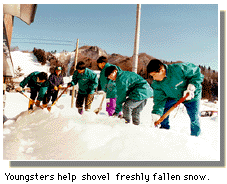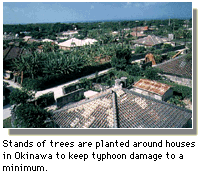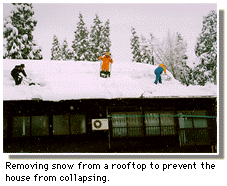Winter generally brings huge snowfalls to the parts of the main island of Honshu facing the Sea of Japan. Houses in this part of the country generally have especially thick internal supporting posts to keep the weight of the snow on the roof from causing the house to collapse. They also have snow stoppers on the roof to keep the snow from sliding off unexpectedly. In some rural communities the traditional practice of extending the eaves to cover a road or path in front of the house can still be seen, but in the cities and towns arcades are now used instead.
 In the past, people warmed themselves around a large open hearth and sat at covered tables over small wells built into the floor with a charcoal warmer underneath. Nowadays people mainly use gas, kerosene, and electric heating. In the old days the heavy snows used to shut people in for the winter; the only way they could get around was on foot, wearing snowshoes or other special footgear. But now many roads are kept clear of snow with sprinkled water, fed through underground pipes. Snowplows and other snow removal equipment are also used to keep the main roads and train tracks open, though sometimes it may take a while to clear away an especially heavy snowfall.
In the past, people warmed themselves around a large open hearth and sat at covered tables over small wells built into the floor with a charcoal warmer underneath. Nowadays people mainly use gas, kerosene, and electric heating. In the old days the heavy snows used to shut people in for the winter; the only way they could get around was on foot, wearing snowshoes or other special footgear. But now many roads are kept clear of snow with sprinkled water, fed through underground pipes. Snowplows and other snow removal equipment are also used to keep the main roads and train tracks open, though sometimes it may take a while to clear away an especially heavy snowfall.
 The summer and fall seasons bring typhoons to Japan. Okinawa, which is the southernmost part of the country, gets hit most frequently. The people of Okinawa try to minimize the damage by building stone walls and planting stands of trees to block the wind. They also use stucco to fasten their roof tiles securely.
The summer and fall seasons bring typhoons to Japan. Okinawa, which is the southernmost part of the country, gets hit most frequently. The people of Okinawa try to minimize the damage by building stone walls and planting stands of trees to block the wind. They also use stucco to fasten their roof tiles securely.
Photos courtesy of Niigata Prefecture, Asahi Shogakusei Shimbun, and Okinawa Prefecture.


 Winter generally brings huge snowfalls to the parts of the main island of Honshu facing the Sea of Japan. Houses in this part of the country generally have especially thick internal supporting posts to keep the weight of the snow on the roof from causing the house to collapse. They also have snow stoppers on the roof to keep the snow from sliding off unexpectedly. In some rural communities the traditional practice of extending the eaves to cover a road or path in front of the house can still be seen, but in the cities and towns arcades are now used instead.
Winter generally brings huge snowfalls to the parts of the main island of Honshu facing the Sea of Japan. Houses in this part of the country generally have especially thick internal supporting posts to keep the weight of the snow on the roof from causing the house to collapse. They also have snow stoppers on the roof to keep the snow from sliding off unexpectedly. In some rural communities the traditional practice of extending the eaves to cover a road or path in front of the house can still be seen, but in the cities and towns arcades are now used instead.
 In the past, people warmed themselves around a large open hearth and sat at covered tables over small wells built into the floor with a charcoal warmer underneath. Nowadays people mainly use gas, kerosene, and electric heating. In the old days the heavy snows used to shut people in for the winter; the only way they could get around was on foot, wearing snowshoes or other special footgear. But now many roads are kept clear of snow with sprinkled water, fed through underground pipes. Snowplows and other snow removal equipment are also used to keep the main roads and train tracks open, though sometimes it may take a while to clear away an especially heavy snowfall.
In the past, people warmed themselves around a large open hearth and sat at covered tables over small wells built into the floor with a charcoal warmer underneath. Nowadays people mainly use gas, kerosene, and electric heating. In the old days the heavy snows used to shut people in for the winter; the only way they could get around was on foot, wearing snowshoes or other special footgear. But now many roads are kept clear of snow with sprinkled water, fed through underground pipes. Snowplows and other snow removal equipment are also used to keep the main roads and train tracks open, though sometimes it may take a while to clear away an especially heavy snowfall. The summer and fall seasons bring
The summer and fall seasons bring 